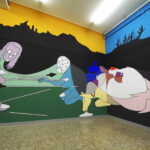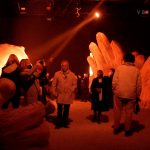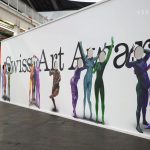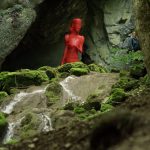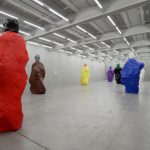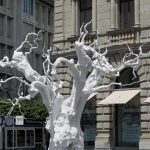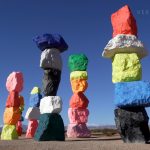From 16 September to 3 December 2023, the Kunstmuseum Thun is presenting in a group exhibition works by international artists who use the circus motif as a metaphor for examining current social issues and questioning political structures. The show is titled Not My Circus, Not My Monkeys and features works by Kathryn Andrews, Miriam Bäckström, Istvan Balogh, Beni Bischof, Mona Broschàr, Barbara Breitenfellner, Michael Dannenmann, Latifa Echakhch, Nicola Hicks, Zilla Leutenegger, Taus Makhacheva, Dieter Meier, Yves Netzhammer, Tal R, Augustin Rebetez & Martin Zimmermann, Boris Rebetez, Ugo Rondinone, Niklaus Rüegg, Francisco Sierra, Norbert Tadeusz, and William Wegman. The exhibition has been co-curated by Helen Hirsch and Katrin Sperry.
Not My Circus, Not My Monkeys: The Circus Motif in Contemporary Art / Kunstmuseum Thun in Thun, Switzerland. Vernissage, September 15, 2023.
> Right-click (Mac: ctrl-click) this link to download Quicktime video file.
Press text (excerpt):
Kathryn Andrews, Miriam Bäckström, Dieter Meier, Ugo Rondinone – from 16 September to 3 December 2023, the Kunstmuseum Thun is presenting in a group exhibition works by international artists who use the circus motif as a metaphor for examining current social issues and questioning political structures.
The first circuses were held in the late eighteenth century, at that time still in fixed buildings and mainly in London. Over the course of the nineteenth century, circuses then became a mass phenomenon anchored in European urban life. They attracted numerous people from the arts and letters, music and film. Circus motifs were gradually taken up by naturalist painters as well as by the avant-garde and exponents of New Objectivity and Expressionism. Today, the circus as a locus of sensual experiences and extremes may seem like a relic of bygone times. And yet contemporary artists still draw on the repertoire of the circus in their formal language, demonstrating that the circus, with its history, repertoire and popularity, has lost none of its relevance even today. On both a micro and a macro level, the circus offers an ideal metaphor for spotlighting current social conflicts, exposing instances of stigmatization, questioning prevailing power structures, and illuminating how humans relate to animals. The circus thus serves as a mirror of both our past and the present day.
Clownesque intermezzo
Whether funny, sad, challenging, thoughtful or naïve, clowns can be found in many artistic works. They populate, for example, the whimsical and colourful world created by artist Beni Bischof from St. Gallen. In his interactive sculptures, the artist has transformed the circus spectators into lumps of plaster as a commentary on our thriving entertainment culture. Zurich artist Istvan Balogh addresses the issue of sensory overload in today’s society by showing the clown as a victim. A melancholy mood is evoked by the often apathetic-looking clown figures created by the New York-based Schwyz artist Ugo Rondinone, their clown shoes symbolically hung up on the wall. US artist Kathryn Andrews, by contrast shows an abandoned clown costume as a melancholy veil, while Swedish artist Miriam Bäckström takes up the very same kind of costume to pose questions about authenticity and identity.
Animals in the arena
When animals (of prey) are kept in captivity, the human need for control and order comes to the fore. The artist Augustin Rebetez from the Jura region turns the power balance between animal tamer and tamed animal on its head in a brutal manner. Yves Netzhammer from Zurich focuses on the monkey as a human- like creature that mirrors our own arrogant attitude. The animal figures depicted by Nicola Hicks from London have seized power from the circus director. They appropriate discarded urban objects to balance on, pointing to both the devastation of the planet as well as the hope that nature will prove to be resilient. Finally, a conciliatory gesture can be sensed in the wall projections by Zurich-based artist Zilla Leutenegger: They portray a childish fantasy in which animal and human can relate to each other on an equal standing.
The art world as a circus
The art world itself is also metaphorically linked to the circus in certain works in the exhibition. The collages by Barbara Breitenfellner from Berlin, for example, offer glimpses of dreamlike states in which the circus always plays a part. In her many years engaging with this theme, the artist has frequently transposed the circus motif onto the world of art and even exposed the art scene itself as being a circus. In Taus Makhacheva’s video work, a tightrope walker balances at dizzying heights while transporting artworks from one highland peak to another. The protagonist in the video comes from Dagestan, which is considered the origin of tightrope walking and is home to many circus artists. With the act of rearrangement, the Russian artist literally questions the linear historiography of art. Metaphorically, however, the balancing act also stands for the history of a region that is caught in the tension between modernity and tradition, representation and invisibility.
The Kunstmuseum Thun presents mainly contemporary art in four to five temporary exhibitions each year. In addition to thematic and solo exhibitions, one collection presentation each year sheds light on part of the museum’s rich holdings from a specific point of view. Art education has a permanent place in the museum: A wide range of offerings teaches the language of art to people from all generations while leaving plenty of room for personal interpretations. The Kunstmuseum Thun celebrates its 75th anniversary in 2023.
